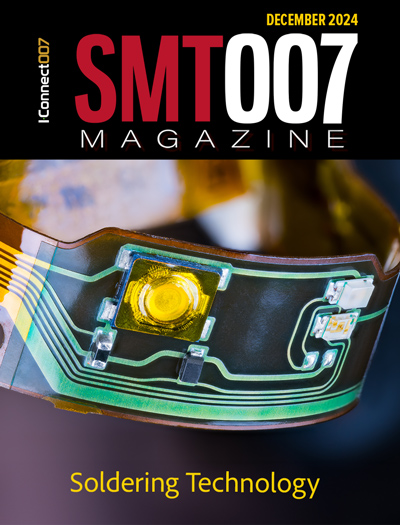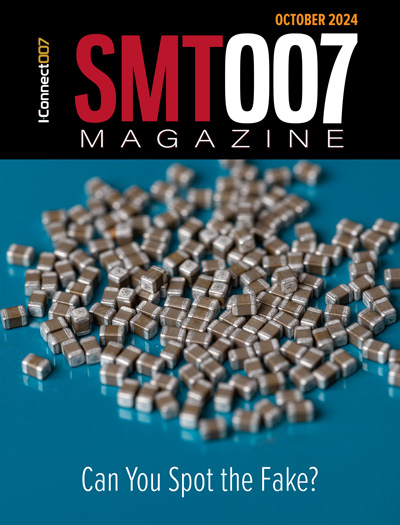-

- News
- Books
Featured Books
- smt007 Magazine
Latest Issues
Current Issue
Soldering Technologies
Soldering is the heartbeat of assembly, and new developments are taking place to match the rest of the innovation in electronics. There are tried-and-true technologies for soldering. But new challenges in packaging, materials, and sustainability may be putting this key step in flux.

The Rise of Data
Analytics is a given in this industry, but the threshold is changing. If you think you're too small to invest in analytics, you may need to reconsider. So how do you do analytics better? What are the new tools, and how do you get started?

Counterfeit Concerns
The distribution of counterfeit parts has become much more sophisticated in the past decade, and there's no reason to believe that trend is going to be stopping any time soon. What might crop up in the near future?
- Articles
- Columns
Search Console
- Links
- Media kit
||| MENU - smt007 Magazine
An Electrifying Improvement in Copper Conductivity
December 28, 2023 | PNNLEstimated reading time: 1 minute
A common carbon compound is enabling remarkable performance enhancements when mixed in just the right proportion with copper to make electrical wires. It’s a phenomenon that defies conventional wisdom about how metals conduct electricity. The findings, reported December 2023 in the journal Materials & Design, could lead to more efficient electricity distribution to homes and businesses, as well as more efficient motors to power electric vehicles and industrial equipment. The team has applied for a patent for the work, which was supported by the Department of Energy (DOE) Advanced Materials and Manufacturing Technologies Office.
Materials scientist Keerti Kappagantula and her colleagues at DOE’s Pacific Northwest National Laboratory discovered that graphene, single layers of the same graphite found in pencils, can enhance an important property of metals called the temperature coefficient of resistance. This property explains why metal wires get hot when electric current runs through them. Researchers want to reduce this resistance while enhancing a metal’s ability to conduct electricity. For several years they have been asking whether metal conductivity be increased, especially at high temperatures, by adding other materials to it. And if yes, can these composites be viable at commercial scale?
Now, they’ve demonstrated they can do just that, using a PNNL-patented advanced manufacturing platform called ShAPE™. When the research team added 18 parts per million of graphene to electrical-grade copper, the temperature coefficient of resistance decreased by 11 percent without decreasing electrical conductivity at room temperature. This is relevant for the manufacturing of electric vehicle motors, where an 11 percent increase in electrical conductivity of copper wire winding translates into 1 percent gain in motor efficiency.
“This discovery runs counter to what’s generally known about the behavior of metals as conductors,” said Kappagantula. “Typically, introducing additives into a metal increases its temperature coefficient of resistance, meaning they heat up faster at the same current levels compared to pure metals. We are describing a new and exciting property of this metal composite where we observe enhanced conductivity in a manufactured copper wire.”
Suggested Items
Coherent Evaluates Strategic Alternatives for Its Advanced Lithium-Ion Battery Recycling Technology
12/13/2024 | Globe NewswireCoherent Corp., a global leader in materials, networking, and lasers, today announced that as a result of an ongoing strategic portfolio assessment, the company will evaluate strategic alternatives for its Streamlined Hydrometallurgical Advanced Recycling Process (SHARP™) technology to efficiently recover and recycle critical metals from lithium-ion batteries (LiBs).
Exploring Innovation Through Alternate Metals and Sputtering
11/11/2024 | Marcy LaRont, I-Connect007Dr. Evelyne Parmentier has a PhD in physical chemistry from ETH Zurich. She was born in Luxembourg and is now a proud resident of Switzerland, where she has been part of Dyconex’s R&D engineering team for the past two years. Evelyne gave a presentation at the EIPC Summer Conference titled “Functionalization of Printed Circuit Boards Through Introducing Alternate Metals Through Sputtered Layers,” where she asked her audience, “If there are 93 metals in the periodic table, why are we not using more of them?”
Marcy’s Musings: Destination Metallization
10/17/2024 | Marcy LaRont -- Column: Marcy's MusingsTo reach your intended destination, you must have some form of pathway or route upon which to travel. It is much the same with the metallized traces and features on a printed circuit board. They are how electrical signals and power are carried from one point to another in an electronic device. Copper is the most prevalent metal conductor, but other metals are also used to a lesser degree, including gold, silver, tin, and palladium.
Fresh PCB Concepts: The Journey of a PCB—A Tale of Sustainability and Circularity
09/18/2024 | Team NCAB -- Column: Fresh PCB ConceptsImagine a bustling factory floor where hundreds of PCBs hum with potential, each one destined to be the brain of a new electronic device. From the sleek smartphone in your pocket to the intricate systems in electric vehicles, PCBs are the unsung heroes of our digital world. But have you ever wondered what happens to these tiny powerhouses when their work is done? The journey of a PCB doesn’t end when a device reaches the end of its life. In fact, that’s where the next chapter begins—a chapter that’s critical for our environment and our future.
Royal Mint Launches Gold Recovery Factory from E-Waste
08/08/2024 | Royal MintA pioneering new factory that provides a more sustainable source of gold and reduces reliance on mining has been unveiled by The Royal Mint.


